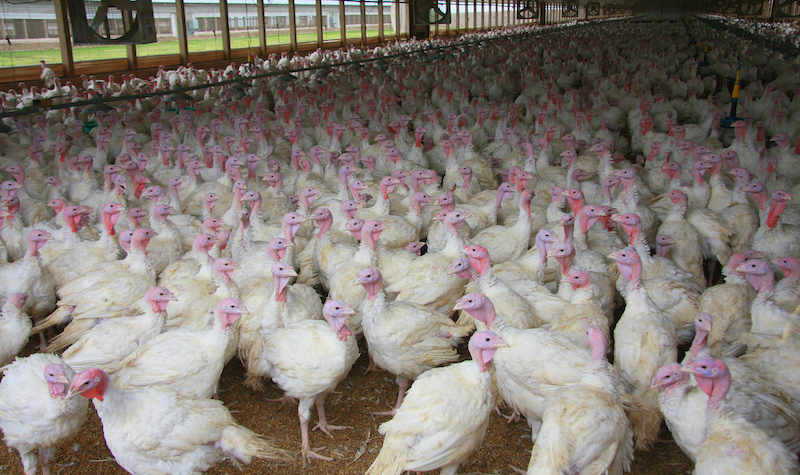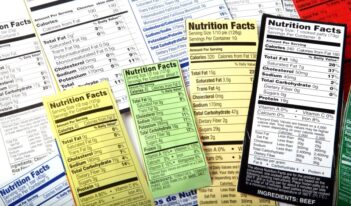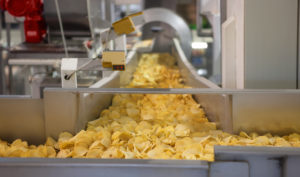
Facing a host of turkey products, ethically conscious consumers should research which kind of labels truly reveal humane practices.
As households across the country begin preparing their Thanksgiving feasts, a substantial number of Americans know little about the life—or death—of the animal who will serve as their table centerpiece.
The National Turkey Federation estimates that each year as many as 90 percent of U.S. consumers collectively eat about 46 million turkeys. Another 22 million turkeys are killed for Christmas dinner.
Investigations reveal that most turkeys found on supermarket shelves in North America were raised by the thousands in overcrowded, industrial facilities without access to fresh air or the outdoors—a miserable life no living being would be thankful for.
A world of difference exists in how individual turkey brands raise and slaughter birds. Fortunately, for those consumers interested in an alternative to traditionally raised turkeys, more options than ever exist. While a vast majority of turkeys are still raised on factory farms, specialty products such as “free range” and “organic” turkeys are increasing.
But buyers should beware. A slew of misleading turkey labels—effectively sanctioned by the U.S. Department of Agriculture (USDA)—hinder consumers from properly evaluating animal welfare and environmental claims.
For example, consumers might assume they are getting a higher-welfare product if they choose a turkey labeled “USDA Certified Organic.” USDA certification, however, does not include robust standards for animal welfare. USDA-certified organic standards contain only vague welfare criteria, and in 2018 USDA withdrew an Obama-era rule meant to raise the standard of care for chickens and turkeys under this program.
Another popular claim on turkey products—“free range”—similarly does not guarantee better animal welfare. The USDA defines this claim as animals having “been allowed access to the outside,” yet this characterization comes with neither independent verification nor requirements concerning a range’s quality and quantity. In reality, the “range” may be no more than a small stretch of gravel or dirt.
In industrial systems, turkeys that may reach 20 pounds or more are packed tightly together, each limited to only a few feet of space. Producers perform painful mutilations—such as cutting off the ends of a bird’s beak, toes, and waddle—to stop aggressive behaviors that result from these over-crowded, stressful conditions. They typically confine turkeys to windowless sheds to minimize aggression and encourage weight gain.
Turkeys in industrial systems are also exposed to high levels of toxins such as ammonia from waste and suffer from a variety of health and welfare issues due to selective breeding for faster growth and higher meat production. Heritage breeds raised in traditional range-based systems that prioritize longer lifespans outdoors take about 28 weeks to reach market weight. In contrast, today’s commercial male turkey reaches market weight in just 18 weeks. Modern turkeys grow so abnormally fast that their bodies cannot keep up—they often suffer from skeletal deformities and lameness and are too large to mate naturally.
Inhumane conditions continue during transport from the farm and at the slaughterhouse. Every year, government inspectors document the suffering of tens of thousands of chickens and turkeys from suffocation, blunt force trauma, and heat or cold stress—much of it occurring before the birds even reach the slaughter line. Among the recent incidents:
- Inspectors cited the Moroni Norbest brand turkey processing plant in Utah approximately 20 times over a two-year period for holding birds on trucks without food, water, or proper protection from extreme temperatures for a day or more.
- Inspectors cited the Butterball turkey plant in North Carolina for keeping truckloads of hens crammed in small cages on the premises without food or water for 31 hours. Inspectors noted that the birds showed evidence of attacking one another. Blood was visible on some birds’ beaks, and numerous birds had large, exposed wounds.
- Inspectors cited a Jennie-O slaughter plant in Minnesota nine times within a four-month period for severe injuries to turkeys, including large areas of “torn skin, hemorrhage, and muscle mutilation” due to malfunctioning equipment.
In August, the Animal Welfare Institute and Farm Sanctuary sued USDA “for failing to require humane handling of poultry at slaughter,” which can compromise food safety and meat quality.
Consumers committed to purchasing higher-welfare turkey and other meat products should seek out producers whose practices are verified by independent auditing programs. Animal welfare standards can vary greatly, however, even among third-party food certifications. Some programs reflect only marginal improvement over conventional industry practices.
To help consumers make more informed food choices, the Animal Welfare Institute publishes a comprehensive guide to animal-raising claims commonly found on meat, egg, and dairy products. The guide identifies labels that consumers can trust, such as A Greener World’s “Certified Animal Welfare Approved” label and Global Animal Partnership’s Steps 4, 5, and 5+, along with claims that are too vague or subjective to have any bearing on animal welfare, such as “natural,” “thoughtfully raised,” and “ethically raised.”
Although consumers can identify turkey products that come from birds experiencing a life worth living, some research and investigation is required to navigate the maze of competing brands and confusing labels.
A more surefire alternative that would ensure a holiday dinner is cruelty-free is simply to leave turkey off the plate. Indeed, a growing number of Americans are celebrating life and compassion during the holiday season by choosing to serve delicious, plant-based protein options.




